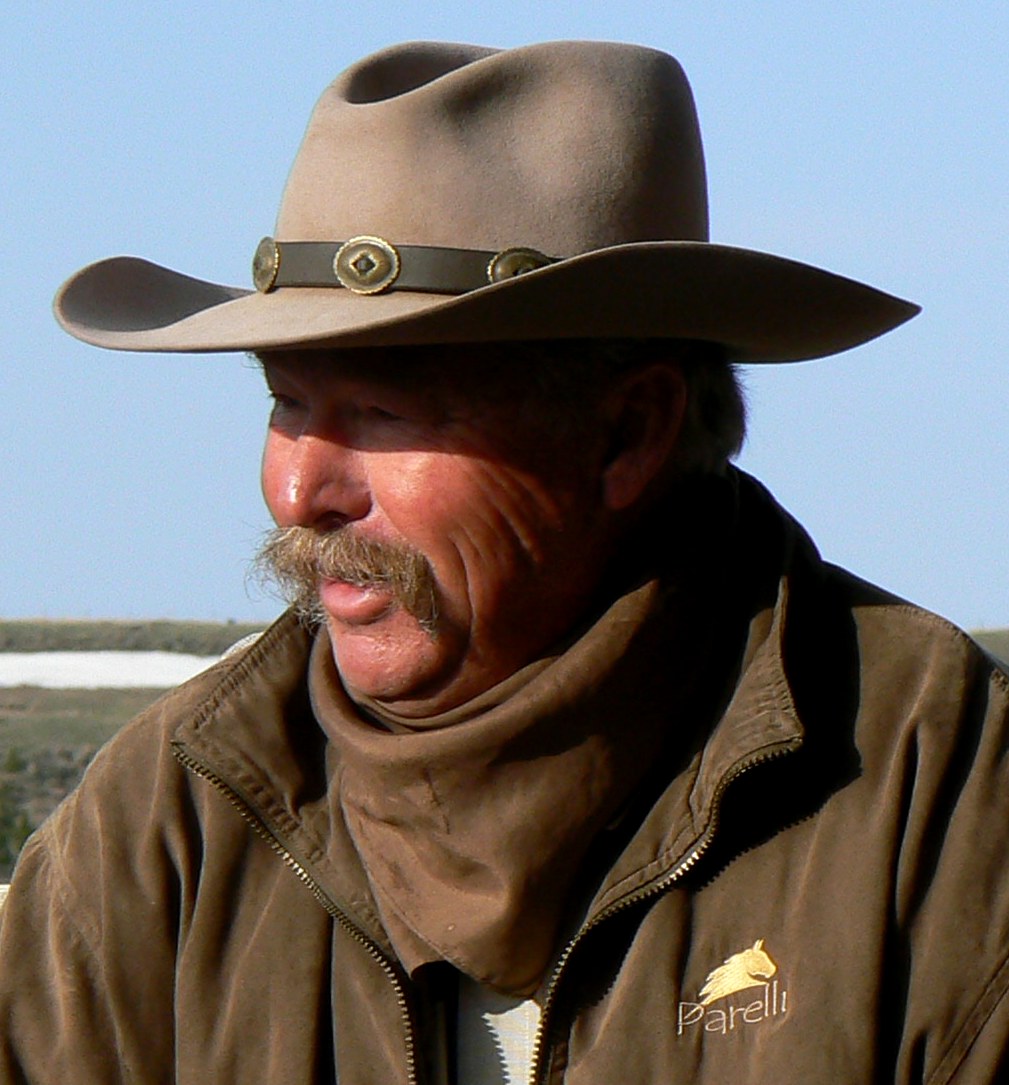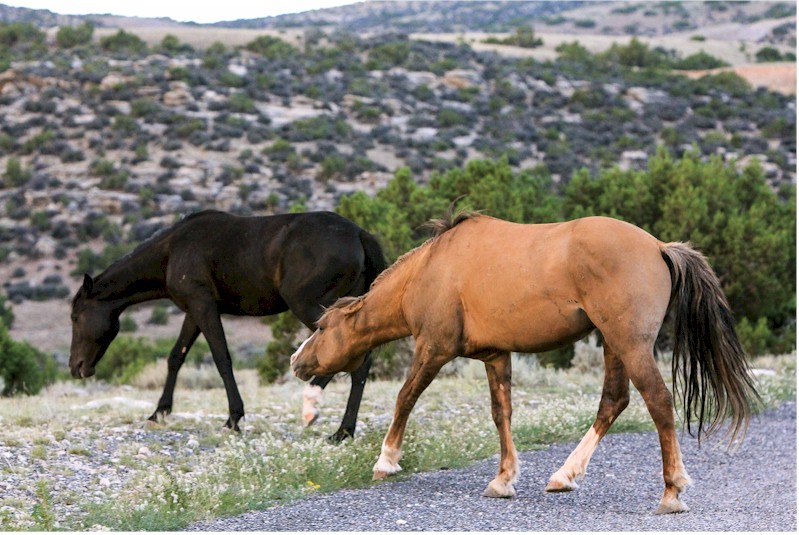DON’T MAKE ME PICK UP THE STICK !
My horse is my partner and best of all, my friend. I strive to give him information in a manner that makes sense to him (responsibility #3). It works out that this is usually substantially different from what seem best from my internal perspective. If I had a dollar for every time that I heard Pat Parelli tell his students that the back of his hand was just like mother’s soft nose, or to answer an inquiring student’s request for advise with the phrase “Would the lead mare let him do that?”, I’d have thousands of dollars and could pay off the ranch mortgage and go fishing. So I do my best to look from my horse’s perspective at things that I ask him to do. How I use of my carrot stick is a biggie!
When Pat was personally teaching students he would often point out that the lead mare in the wild horse band (or alpha gelding in the group in town) would look, put her ears back, throw her head around, then and only then kick or bite. That’s the reason for our 4 phases. Our horses don’t need to learn about phases, they are already encoded on their DNA. We are the ones that ignore phases. In human terms it’s called Incrementalism, and predators (that’s us) simply ignore them. Don’t believe me! What do you think the original U.S. Income tax rate was? What do you think the original property tax or state sales tax was on your day to day living? That’s right! A whole lot less than it is now, and nobody minded because it was just a couple of dollars a year, or month. That’s the way we humans operate. NOT OUR HORSES ! They are very much aware as Linda and Pat say repeatedly of the slightest changes in people, places, and things. When our carrot stick changes in perspective to the horse, it’s a big deal to our horse. Likewise if our stick stays the same, it becomes meaningless to our horse. This will be a good thing for our horse when we wish for him to become more comfortable and confident with the stick, but if we wish for him to become more responsive and aware of the stick, passive consistency may not be for the best.
How do we become more adept with the carrot stick? How do we cause the stick to be information rather than punishment? How do we cause our horse to become responsive to the carrot stick and at the same time not afraid of it? Here’s what has worked best for me for about 15 years.
In 1999 Mark Berry and I put together a “Wild Horse and Horsemanship Weekend” north of Reno on the border line of Nevada and California. Mark knew the rancher on this property that had 3 bands of wild horses running on it. Best of all, the property had a cone shaped mountain smack in the middle of the property that allowed us to view the horse bands from above while they rotated around this dormant prehistoric volcano throughout the weekend. The horses would graze for and hour or two, then move to another meadow. We just rotated around the top portion on this cone. It was perfect for quietly observing these mustangs with minimal impact on them. We camped on the property, did horsemanship workshops in the morning, and watched the mustangs in the afternoon.
Lo and Behold! Those
1940 and 1950 westerns were all wrong!
The stallion did not take his band to safety and lead the charge if
 danger appeared. What we observed time
and time again was the LEAD MARE, and it didn’t take too long to spot her,
would lift her head, get a far-away look about her, walk off, then ease into a
trot. The remaining mares would follow;
but not all of them. A few would hang
back grabbing at the last morsels of grass to be had there. Now, the stallion would show up IN THE BACK
where the stragglers were. He’d show up
and one on two would leave; but not all.
Then he’d get serious and snake his head around. By then the remainder had caught up
danger appeared. What we observed time
and time again was the LEAD MARE, and it didn’t take too long to spot her,
would lift her head, get a far-away look about her, walk off, then ease into a
trot. The remaining mares would follow;
but not all of them. A few would hang
back grabbing at the last morsels of grass to be had there. Now, the stallion would show up IN THE BACK
where the stragglers were. He’d show up
and one on two would leave; but not all.
Then he’d get serious and snake his head around. By then the remainder had caught up with the
band. I remembered Pat telling us that
the stallion has 3 jobs: procreate the herd, defend the herd from predators and
other stallions, and lastly to keep the stragglers caught up so they don’t get
picked off by predators.
with the
band. I remembered Pat telling us that
the stallion has 3 jobs: procreate the herd, defend the herd from predators and
other stallions, and lastly to keep the stragglers caught up so they don’t get
picked off by predators.
The third day of horsemanship while we were playing with the circling game, it hit me like a ton of bricks.
I was emulating the band of wild horses! (not the procreate part)
While improving our send in game # 5 the circling game, we were saying “lead it, lift it, swing it, touch it” with an appropriate allow when we got some compliance. It suddenly occurred to me; what if my horse was the band of mares, my lead line was the lead mare, and my carrot stick was the stallion? Then my fertile imagination went ballistic!
The
lead mare would raise her head and focus toward the next meadow
I raise my
arm and focus in the direction I wish my horse to go.
If all
the mares followed, the stallion did not bother anyone
If all 5
zones of my horse went where I focused, the carrot stick did not raise.
When
some mares did not follow the lead mare, the stallion would run to the back of
the herd.
If my
horse did not go, I would lift my carrot stick.
If some
mares still stayed, the stallion would throw his head around or snake it on the
ground.
If my
horse still did not leave, I would swing my carrot stick
If a
mare still stayed, the stallion would kick or bite at the mare till she
followed the herd.
If my
horse still stayed, I would touch something meaningful.
When the stragglers moved,
the stallion would immediately stop.
He
did not give them “One for the road”.
The instant my horse moved, I would drop the end of the stick providing the best release possible.
As we watched the mustangs that afternoon I imagined that I was there lifting my arm or raising my stick. It was obvious that the lead mare was the genuine leader with all the good ideas and with the best interest of the herd in mind. The stallion is the enforcer making sure that her wishes are followed. Yes, the lead mare can and will get strong with any other member of the herd, even the stallion, when necessary; but she is not the power. She is the brains.
When I got back home and tried to really play with this concept, the change in me was enormous. I no longer felt like a bad guy trying to make sure everything went just right. I would use my lead line or my rein to suggest a place to be. If my horse wasn’t interested in following this good advice, I did not become frustrated or irritated. I just sent for the stallion or my carrot stick. He would show up, swing his head around, then kick or bite someone. In no time at all my horse would be advising me to keep that stallion to myself by moving off of my suggestion.
I WAS NOT PICKING UP MY STICK near as much.
I soon noticed that these thought processes that I was using were meaningful to every horse that I played with. That’s when it dawned on me. If we turn our horses loose with a band of wild horses, they don’t need a 30 day orientation program to fit in. They are horses and these responses are encoded on their DNA. They know about this already. We are the ones that have to learn from Pat and Linda the importance of our phases and appropriate use of out tools. I was just lucky enough to fall onto a thought process that keeps me smiling, keeps a song in my heart, and still allows me to remain an effective leader for my friend, the horse.
Give it a try, and good luck. - Ranger Dave